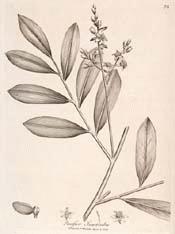
Botanical.com Home Page

|
Simaruba
(Simarouba amara
printed as Quassia Simaruba)
Click on graphic for larger image
|
Simaruba
Botanical: Simaruba amara (D. C.), Simaruba officinalis
Family: N.O. Simarubaceae
---Synonyms---Dysentery Bark. Mountain Damson. Bitter Damson. Slave Wood. Stave Wood. Sumaruppa. Maruba. Quassia Simaruba.
---Part Used---Dried root-bark.
---Habitat---French Guiana, the Islands of Dominica, Martinique, St. Lucia, St. Vincent and Barbados.
---Description---The name given by the founder of the genus was Carib Simarouba, but later writers adopted the present spelling.
The tree is 60 feet or more in height, with many long, crooked branches covered with smooth, greyish bark, leaves 9 to 12 inches long, and flowers growing in small clusters, with rather thick, dull-white petals. The bark is usually found in pieces several feet long, the roots being long, horizontal, and creeping. Very often the outer bark has been removed, when it shows a pale yellowish or pinkish-brown surface. It is odourless, difficult to powder, and intensely bitter. It is usually imported from Jamaica, in bales.
---Constituents---Simaruba root-bark contains a bitter principle identical with quassin, a resinous matter, a volatile oil having the odour of benzoin, malic acid, gallic acid in very small proportion, an ammoniacal salt, calcium malate and oxalate, some mineral salts, ferric oxide, silica, ulmin, and lignin.
It readily imparts its virtues at ordinary temperatures to water and alcohol. The infusion is as bitter as the decoction, whichbecomes turbid as it cools.
---Medicinal Action and Uses---A bitter tonic. It was first sent from Guiana to France in 1713 as a remedy for dysentery. In the years 1718 and 1725 an epidemic flux prevailed in France, which resisted all the usual medicines. Simaruba was tried with great success, and established its medical character in Europe. It restores the lost tone of the intestines, promotes the secretions, and disposes the patient to sleep. It is only successful in the latter stage of dysentery, when the stomach is not affected. In large doses it produces sickness and vomiting. On account of its difficult pulverization, it is seldom given in substance, the infusion being preferred, but like many bitter tonics, it is now seldom used. From its use, it has been called 'dysentery bark.'
[Top]
---Dosage---From 20 grains to a drachm. A 1/4 OZ. of simaruba may be infused for 12 hours in 12 OZ. of cold or boiling water, and a wineglassful of the infusion taken every three or four hours.
Fluid extract, 1/2 to 1 drachm.
---Other Species---
Simaruba glauca of Jamaica, San Domingo, Bahama Islands, Panama and Guatemala has identical properties, and by some writers is regarded as the same tree, others distinguishing it by a slight difference in the flowers. It is also known as Winged-leaved Quassia, and S. medicinalis.
S. versicolor of Brazil, has similar properties, the fruit and bark being also used as anthelmintics, and an infusion of the latter being employed in cases of snake-bite. The plant is so bitter that insects will not attack it, on which account the powdered bark has been employed to kill vermin.
S. glauca of Cuba furnishes a glutinous juice, which is employed in certain skin diseases.
S. excelsa or Quassia Excelsa yields quassin from boiled slices of the wood, furnishing the Quassia of commerce, substituted for the true Surinam Quassia.
Samadera Indica contains a similar bitter principle in its bark.
See QUASSIA.
[Top]
Common Name Index
A MODERN HERBAL Home Page
Bear in mind "A Modern Herbal" was written with the conventional wisdom of the early 1900's. This should be taken into account as some of the information may now be considered inaccurate, or not in accordance with modern medicine.
© Copyright Protected 1995-2024 Botanical.com
|

